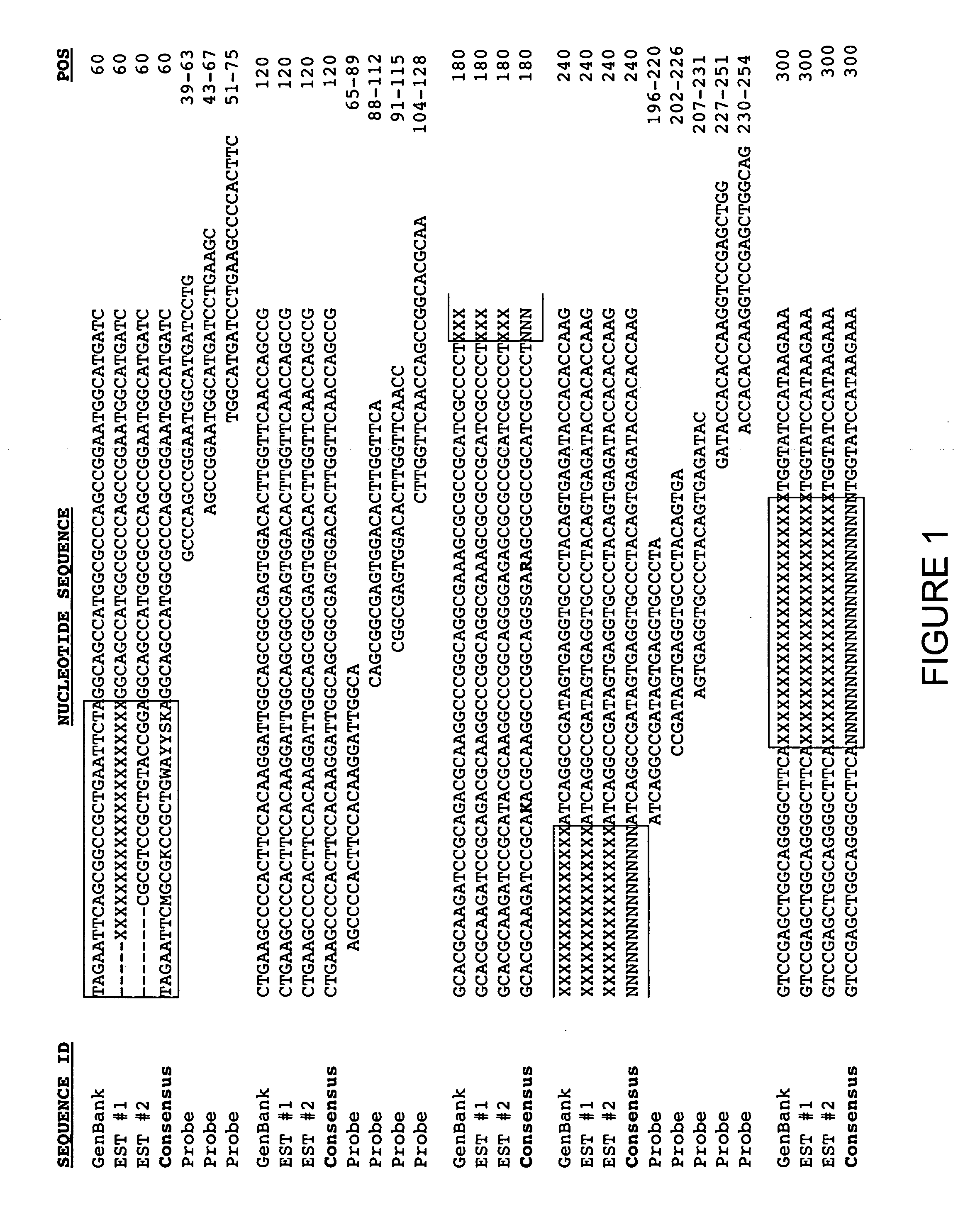Oligonucleotide arrays to monitor gene expression and methods for making and using same
a technology of oligonucleotide arrays and gene expression, which is applied in the field of oligonucleotide arrays to monitor gene expression, can solve the problems of inability to distinguish even a minority of genes involved in a genetic pathway using the methods described above, and no available method for simultaneous monitoring of transgene expression, etc., to achieve the effect of increasing transgene expression, optimizing transgene expression, and increasing transgene expression
- Summary
- Abstract
- Description
- Claims
- Application Information
AI Technical Summary
Benefits of technology
Problems solved by technology
Method used
Image
Examples
example 1
Generation of an Oligonucleotide Array Usefor for Monitoring Gene Expression by Chinese Hamster Ovary Cells
[0122] Chinese Hamster Ovary (CHO) cells are commonly used for the recombinant production of proteins. Despite the widespread use of CHO cells in the art, only limited sequence analysis of the cell line has been performed, and methods to monitor CHO cell gene expression are not readily available. Consequently, publicly available gene coding sequences from all hamsters, in addition to gene coding sequences from the Chinese hamster, were clustered and aligned to generate consensus sequences. Chinese hamster gene coding sequences and EST sequences were obtained either from publicly available sources or through use of CHO cDNA libraries made by well-known methods in the art.
example 1.1
Generation of CHO cDNA Library
[0123] Generation of a cDNA library is a well-known method in the art. Briefly, a cDNA library is constructed from a source of a pool of MRNA, which is subsequently reverse transcribed into cDNA. The resulting pool of cDNA is then ligated into a population of an appropriate expression vector to form the cDNA library. Well-known methods for efficient cDNA—expression vector ligation, such as tailing, linker / adaptor insertion, and vector priming, are described in the art, e.g., Kriegler, M. P. (1990) Gene Transfer and Expression: A Laboratory Manual, W.H. Freeman and Company, NY, pp. 117-31. Additionally, methods for cDNA library amplification, isolation, and sequencing are also well known in the art.
[0124] One of skill in the art will recognize that the source of mRNA depends on the cell line to be monitored, as described above. It is preferred that the mRNA is isolated from either the cells or cell line(s) to be monitored, or the animal from which the ...
example 1.2
Identification of Consensus Sequences
[0126] All hamster sequences, either gene coding sequences publicly available from GenBank or generated with prediction algorithms (1,358 sequences) or EST sequences derived from a CHO cDNA library (4,120 sequences) as generated in Example 1.1, were included in a sequence set to be analyzed by clustering and alignment. In a first step, each sequence (i.e., gene coding or EST sequence) of the sequence set was screened for vector and low-complexity sequences. The vector and low-complexity sequences were masked from each gene coding sequence or EST sequence with a poly-X sequence of the same length, and the remaining sequence was either included for clustering and alignment analysis, or excluded because it did not meet the base pair requirement inherent in the preset definition of homologous sequences, e.g., the remaining sequence was 50 base pairs in length whereas the definition of homologous sequences required at least 100 base pairs. The base p...
PUM
| Property | Measurement | Unit |
|---|---|---|
| temperature | aaaaa | aaaaa |
| surface area | aaaaa | aaaaa |
| surface area | aaaaa | aaaaa |
Abstract
Description
Claims
Application Information
 Login to View More
Login to View More - R&D
- Intellectual Property
- Life Sciences
- Materials
- Tech Scout
- Unparalleled Data Quality
- Higher Quality Content
- 60% Fewer Hallucinations
Browse by: Latest US Patents, China's latest patents, Technical Efficacy Thesaurus, Application Domain, Technology Topic, Popular Technical Reports.
© 2025 PatSnap. All rights reserved.Legal|Privacy policy|Modern Slavery Act Transparency Statement|Sitemap|About US| Contact US: help@patsnap.com

